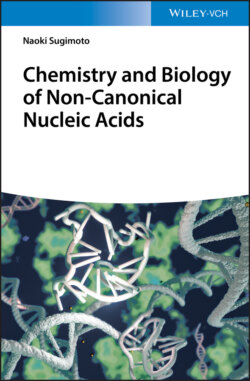Читать книгу Chemistry and Biology of Non-canonical Nucleic Acids - Naoki Sugimoto - Страница 50
3.4.2 Factors Influencing Stability of Quadruplex 3.4.2.1 G-Quadruplexes
ОглавлениеThe basic subunit of a G-quadruplex structure is the G-quartet (Figure 3.8a), composed of a planar cyclic array of four Hoogsteen-paired guanine residues (Figure 3.8a andb) [10]. The spatial proximity of the O6 atoms of guanine in a quartet is unique, with their lone pairs in close approach. This arrangement would be expected to produce significant electrostatic repulsion among the guanine bases. Therefore, the coordination of cations in the center of the G-quartet is required for the stable G-quadruplex formations. The direct cation coordination is investigated by the melting temperature (Tm) of guanosine gels, which is a model of G-quartet in the presence of cations (Figure 3.9) [11]. The Tm values strongly correlate with ionic radius. Moreover, it is also reported that the Tm values for the G-quadruplexes in the presence of various cations show similar trend with the Tm values for guanosine gels. The UV melting profiles for the thrombin aptamer G-quadruplexes show that cations of K+, Rb+, NH4+, Sr2+, and Ba2+ are able to form stable intramolecular cation–G-quadruplex complexes at temperatures above 25 °C. The cations of Li+, Na+, Cs+, Mg2+, and Ca2+ form weaker complexes at very low temperatures (the detail parameters are described below).
Figure 3.8 (a) Hydrogen bond formation in base pairs in a DNA G-quadruplex. The hydrogen bonds are shown in dashed lines. (b) G-quadruplex structures of DNAs are depicted in tube (left) and ball-and-stick (right) models, respectively. Stacking interactions are shown in arrows.
Figure 3.9 Images of the melting temperature of 8-bromoguanosine gels as a function of cation size.
The space among the four O6 carbonyl groups at each guanine in a G-quartet is sufficiently large to accommodate an Na+ coordinated in the plane of the guanine bases. The ionic radius of Na+ is 0.95 Å, and this size is around maximum size of a cation that can be coordinated in the plane of a G-quartet. Larger cations, such as K+, with an ionic radius of 1.33 Å, are too large to be coordinated within G-quartet. Importantly, larger cations are coordinated between the planes of two stacked G-quartets, and the coordination induces large stabilization of G-quadruplex. Cations with an ionic radius in the range of 1.3–1.5 Å fit well within the two G-quartets of the complex, while the other cations cannot. The cations coordinate to two stacked G-quartets with accompanying dehydration of both cations and guanine O6 atomic groups in a G-quartet, determining cation-dependent stability of G-quadruplexes.
